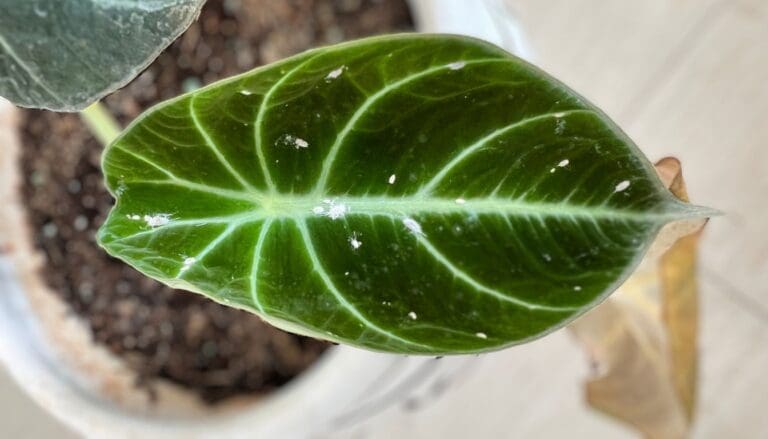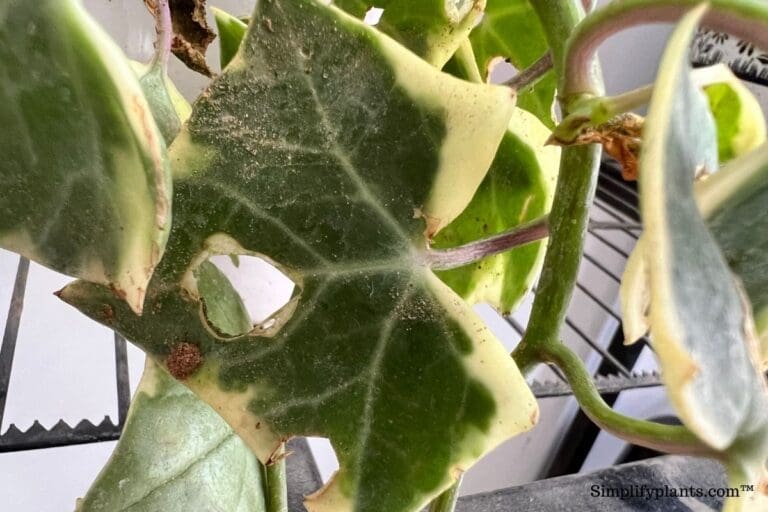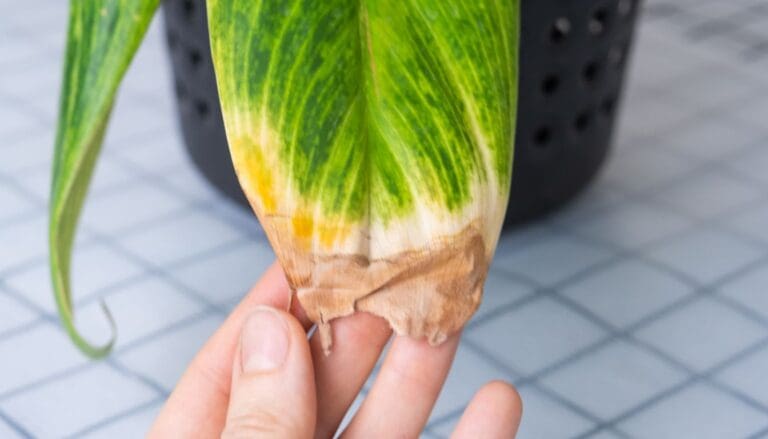Why Is My String Of Pearls Not Growing? (Causes+What to Do)
The string of pearls is known for tolerating extreme conditions such as drought and low light. But it can affect the plant’s health if the conditions remain severe or harsh for an extended period.
The string of pearls is a resilient plant that can thrive in most situations. However, if your string of pearls is not growing, then something is wrong with them, and you need to investigate the same.
The primary reasons why your string of pearls is not growing are a lack of light and overwatering. Damage from pests, high humidity, and diseases can also result in stunted growth. Monitor your plant for signs of stress, provide bright lighting and adequate watering for healthy growth.
The string of pearls originates from the dry regions of southwest Africa and can tolerate extreme conditions, so there will not be much problem if the plant is exposed to unfavorable conditions for a few days.
If you keep your plant in extreme conditions for many days, it will start developing problems, and you will be able to notice the unusual signs.
One common problem is stunted growth. And in this article, we will learn all about why your string of pearls is not growing and how you can promote healthy growth in them.

Please note: Simplify Plants is reader-supported. Some links in the post are affiliate links and I get a commission from purchases made through links in the post.
How fast does the string of pearls grow?
The string of pearls can grow very fast during the growing season if it gets enough light and fertilizer.
However, if the conditions are not favorable, you might have trouble seeing growth in your string of pearls.
The growth of your string of pearls will depend on the amount of light, water, and fertilizer you add to it. External factors like the temperature and humidity of the area can also affect the growth of your string of pearls.
If you don’t see much growth in your string of pearls, you need not worry. Please read this article to find out the problems that your plant might be having due to which it is not growing.
My string of pearls is not growing
When you don’t see any significant growth in your string of pearls, you should understand that there is some problem with it as the string of pearls generally grows fast when it gets favorable conditions.
There can be various growth-related problems in the string of pearls. We’ll take a look at some.
The string of pearls not getting enough light

Your string of pearls will need six to eight hours of indirect sunlight to thrive. If the plant is not getting enough light, it will have different problems.
The string of pearls will not be able to photosynthesize appropriately, and the plant will lack energy and nutrition for growth.
Insufficient light will keep the soil moist for too long that can cause an environment similar to overwatering.
The string of pearls needs a balance of both direct and indirect sunlight. The plant will benefit from the natural morning sunlight, whereas it will need indirect light for the rest of the day.
You need to ensure that your string of pearls gets a sufficient amount and intensity of light for the suitable period. If your string of pearls is not growing correctly or showing other problems due to lack of light, you need to move the plant to a different spot to give it more light.
Also read: How Much Light Does String Of Pearls Need?
Overwatering

The string of pearls doesn’t like to sit on water for too long as it comes from Africa’s dry regions.
When you give the plant too much water, the soil remains wet for longer, and that can cause problems like root rot and pest infestation.
When the roots stay wet for too long, they become mushy and brown and cannot absorb enough water or nutrients. Thus the plant becomes weak, there is no growth, and the roots start to rot.
You need to repot your string of pearls if you have overwatered it. It would be ideal to start a new watering schedule depending on the placement of the plant, the environment of your house, and the soil user for the plant.
Also read: How Often Should You Water String Of Pearls?
The string of pearls is not getting enough nutrients

Many strings of pearl owners don’t like to add fertilizers to the soil. The plant doesn’t wilt due to a lack of fertilizers, but there is slower growth in the plant.
If you want growth in your string of pearls, you need to add fertilizer to the soil. The soil loses nutrition over time, and adding fertilizer helps to add the nutrition back to the soil that the plant absorbs from the soil.
You should use a diluted liquid fertilizer that has a balance of all the required nutrients for your string of pearls.
However, you should avoid fertilizing during the winter months as that is the dormant period for the plant when the growth is negligible, so it will not use the fertilizers, and adding fertilizers can burn the plant’s roots.
Also read: Should You Fertilize String Of Pearls?
Using the wrong soil for the string of pearls

Wrong soil mix can cause many problems like slow or stunted growth, so you should be very careful to select the correct soil mix for your string of pearls.
The string of pearls prefers well-draining soil that allows air to pass between the roots and soil of the plant.
If you use the wrong soil that holds too much moisture, the plant will have root rot even if you are not overwatering it.
Using the wrong soil mix will retain water in the soil and not allow air to flow that will cause root rot in the plant.
Many beginners make the mistake of using a soil mix for the other plants in the house. But the string of pearls has different requirements as it is succulent.
You can use a cactus mix or succulent mix or create your well-draining soil for your string of pearls.
Also read: What Kind Of Soil Does String Of Pearls Need?
Pest infestation on string of pearls

A pest infestation can make your string of pearls weak as the pests suck the nutrients out of the plant. Thus, the plant lacks the energy to carry out all the required activities for healthy growth.
If there is pest infestation on your string of pearls and you don’t get rid of them on time, they can even exterminate your plant.
If you don’t know if your string of pearls has a pest infestation, the following signs can be an indication:
- Yellow leaves
- Drooping leaves
- Discoloration of leaves
- Stunted growth
- Brown leaves
- Slow growth
If you doubt pest infestation, you should check the leaves of the plant. Some pests like to hide under the leaves, so you need to check thoroughly.
You can try using miticides and organic pesticides, and natural remedies like neem oil to get rid of pest infestation in your string of pearls. It will help if you control the pests whenever you discover them.
Also read: Do String Of Pearls Attract Bugs? How to deal with them?
The string of pearls is exposed to direct sunlight

The string of pearls can tolerate direct sunlight in the morning, but the afternoon sunlight becomes too harsh for the plant.
If you place the string of pearls under direct sunlight for too long, it will get scorched, and it will not grow. It will help if you place your string of pearls near a south-facing window.
You can consider using curtains to filter the light. If the window gets direct sunlight, you should keep the plant a few feet away from the window sill.
Wrong humidity level

Many strings of plant owners make a common mistake of thinking that these plants need a lot of humidity.
The string of plants is succulent, and they can do well in average humidity levels of 40 to 50%. If the plant is exposed to higher or lower humidity levels for a longer time, it will face problems, and its growth will slow down.
If you live in a region with low humidity, you can use a humidifier or pebble tray to increase the moisture for your plant.
If your string of pearls is getting too much humidity, you should try to find a spot that gets less humidity than the other areas of your house. Else you can use a dehumidifier to maintain appropriate humidity levels.
The string of pearls grows slowly during the winter season
The string of pearls doesn’t show much growth during the winter season, as this is the dormant period for most of the plants. They like to rest during this period.
You don’t need to worry if you don’t see growth in your string of pearls during the winter season. You can wait for the winter to pass away and then check if the plant is growing.
The light’s intensity decreases during the winter season. So, the plant cannot photosynthesize actively like the rest of the year, and due to this, the growth slows down.
Avoid fertilizing your string of pearls during this time and reduce watering as the plant won’t need much of these during this time.
Insufficient watering

The string of pearls is succulent and drought-resistant. They can last with less water for an extended period. That doesn’t mean that you can skip watering the plant for too long.
When you don’t give enough water to your string of pearls, it uses the water that it stores in the leaves and other parts, and you end up seeing shriveled pearls, yellow leaves, and slow growth in the plant.
The amount of water your string of pearls will need will depend upon various factors such as temperature, humidity, lighting, etc. You should figure a watering schedule for your string of pearls after keeping all the elements in mind and ensure that it doesn’t starve for water.
If your string of pearls gets six to eight hours of indirect sunlight regularly, it will need more water than a plant placed in a low-light area of the house.
Overwatering can be deadly for your string of pearls, but under-watering can also slow down the plant’s growth.
Also read: Overwatering vs Underwatering
Stressed string of pearls
Plants can get stress due to many reasons. If the string of pearls has faced any damage while being repotted, it can get stressed out.
A sudden change of temperature or humidity or being exposed to cold drafts and direct sun can also cause stress or shock the plant.
There can be other reasons such as overwatering, over-fertilization, and under-watering that can cause stress to your string of pearls.
If your string of pearls is suffering from stress, it will have problems like shriveled leaves, leaves turning yellow or brown, and stunted growth.
How can I make my string of pearls grow faster?
If you want to see your string of pearls grow fast, you need to take care of all the factors and ensure that the plant is getting enough of everything.
Light

You can place the string of pearls near an east-facing window in the morning where it gets direct morning sunlight.
Placing the string of pearls near a south-facing window is ideal as it will get six to eight hours of indirect sunlight.
If the window gets direct sunlight, you can place the plant a few feet away from the window. You can also use curtains to filter the direct light.
In case your house doesn’t get enough direct light, you can use artificial lights to provide sufficient light to your string of pearls. You should avoid placing your string of pearls in low light for an extended period as that doesn’t support its growth.
Water

You don’t want to overwater or under-water your string of pearls. Both these can cause problems for the plant.
The watering will depend on the size of your plant. Start by giving less water to the plant if you don’t know how much water the plant needs.
You will need to increase the watering eventually after understanding the water requirements of your plant.
The water requirements will also depend on external factors such as light, temperature, humidity, season, etc. It will help if you keep all these in mind before coming up with a watering schedule for your string of pearls.
Humidity
The strings of pearls are not humidity-loving plants, and they don’t need a lot of humidity.
The string of pearls comes from dry regions where they don’t get a lot of humidity. So an average humidity of 40-50% will work well for these plants.
However, if the humidity levels drop below 40-50% in your area, you should consider using a method to increase the humidity in your home.
You can use a humidifier, a pebble tray or group your string of pearls with other plants to increase the humidity. You can even use a dehumidifier to reduce the humidity levels in your house if the humidity levels are too high.
Soil

The string of pearls needs soil that has a well-draining system. The string of pearls is succulent that doesn’t get good quality soil in its natural habitat.
Using regular soil you give to the other plants will not work well for your string of pearls. You can use a good cactus or succulent mix for your string of pearls.
You can even create a well-draining soil mix by adding two parts potting soil, one part perlite, and one part grit and mix these with a bit of water and use this as the soil mix for your string of pearls.
You need to ensure that you are using soil that provides all the required nutrients and allows air to flow between the roots, which will, in turn, keep the plant healthy and will help it grow.
Fertilizer
The string of pearls doesn’t need much fertilizer, but you should give it some amount to boost its growth and provide sufficient nutrition.
You should not over-fertilize the string of pearls as that will burn the roots of the plant.
Since the strings of pearls are succulents, their fertilizer requirement is different from other plants.
You should use an excellent diluted liquid fertilizer rich in nutrients and minerals for the string of pearls. You can add fertilizer to the plant once or twice during the growing season and avoid fertilizing during the dormant period.
Keep the pests away
If you see pest infestation on your string of pearls, you should act immediately and isolate the plant.
If there are damaged parts, you should prune them. There are various organic options to choose from that you can use on your plant to remove the pests.
You can use 1 tsp neem and add 1 liter of water or add 1 tsp of dishwasher soap and add it to 1 liter of water. You can use any of these and spray on your plant once a week to get rid of pests.
Once your plant has no pests, you need to care for the plant to ensure that the pests don’t come back.
Don’t stress your string of pearls
As discussed earlier, the string of pearls can become stressed due to sudden environmental changes and other reasons like if it is root-bound, if it is repotted, or not getting enough care.
If you want your string of pearls to grow fast and remain healthy, you should try not to cause any stress to the plant, and if it is stressed, you should help it recover.
Don’t repot frequently
The string of pearls doesn’t need repotting often. These plants have a shallow root system, so they don’t get root-bound quickly.
If you repot them very often, they will become stressed or can have any damage due to being repotted again and again.
You can check your string of pearls every year to see if the plant is root-bound, and you need to repot if it is. Otherwise, you need to repot if there is any disease such as root rot or pest infestation.
Ref: Wikipedia, Missouri Botanical Garden, University of Wisconsin.
Recommended Garden Supplies
| Product Image | Our Recommended Gardening Supplies | Check Offers! |
|---|---|---|
Top Top
Top
Top
Top
Top
Top
Top
Top | rePotme Houseplant and Tropical Classic Potting Soil Mix | Check Offer On Amazon |
 Top
Top
Top
Top
Top
Top
Top
Top | Espoma Organic Indoor Plant Food | Check Offer On Amazon |
 Top
Top
Top
Top
Top
Top
Top
Top | GooingTop LED Grow Light 6000K Full Spectrum Clip Plant Growing Lamp | Check Offer On Amazon |
 Top
Top
Top
Top
Top
Top
Top
Top | Soil Moisture Meter | Check Offer On Amazon |
 Top
Top
Top
Top
Top
Top
Top
Top | Govee Hygrometer Thermometer, Bluetooth Enabled! | Check Offer On Amazon |
 Top
Top | LEVOIT Humidifiers for Large Room(Best For Plants) | Check Offer On Amazon |
 Top
Top
Top
Top
Top
Top
Top
Top | Upgraded DIY Automatic Drip Irrigation Kit, 15 Potted Houseplants Support | Check Offer On Amazon |
 Top
Top
Top
Top
Top
Top
Top
Top | Stainless Steel Heavy Duty Gardening Tool Set | Check Offer On Amazon |
 Top
Top
Top
Top
Top
Top
Top
Top | Bonide Insecticidal Soap | Check Offer On Amazon |
 Top
Top
Top
Top
Top
Top
Top
Top | Bonide 32 oz Spray Neem Oil for Organic Gardening | Check Offer On Amazon |
 Top
Top
Top
Top
Top
Top
Top
Top | Garden Safe Fungicide | Check Offer On Amazon |








